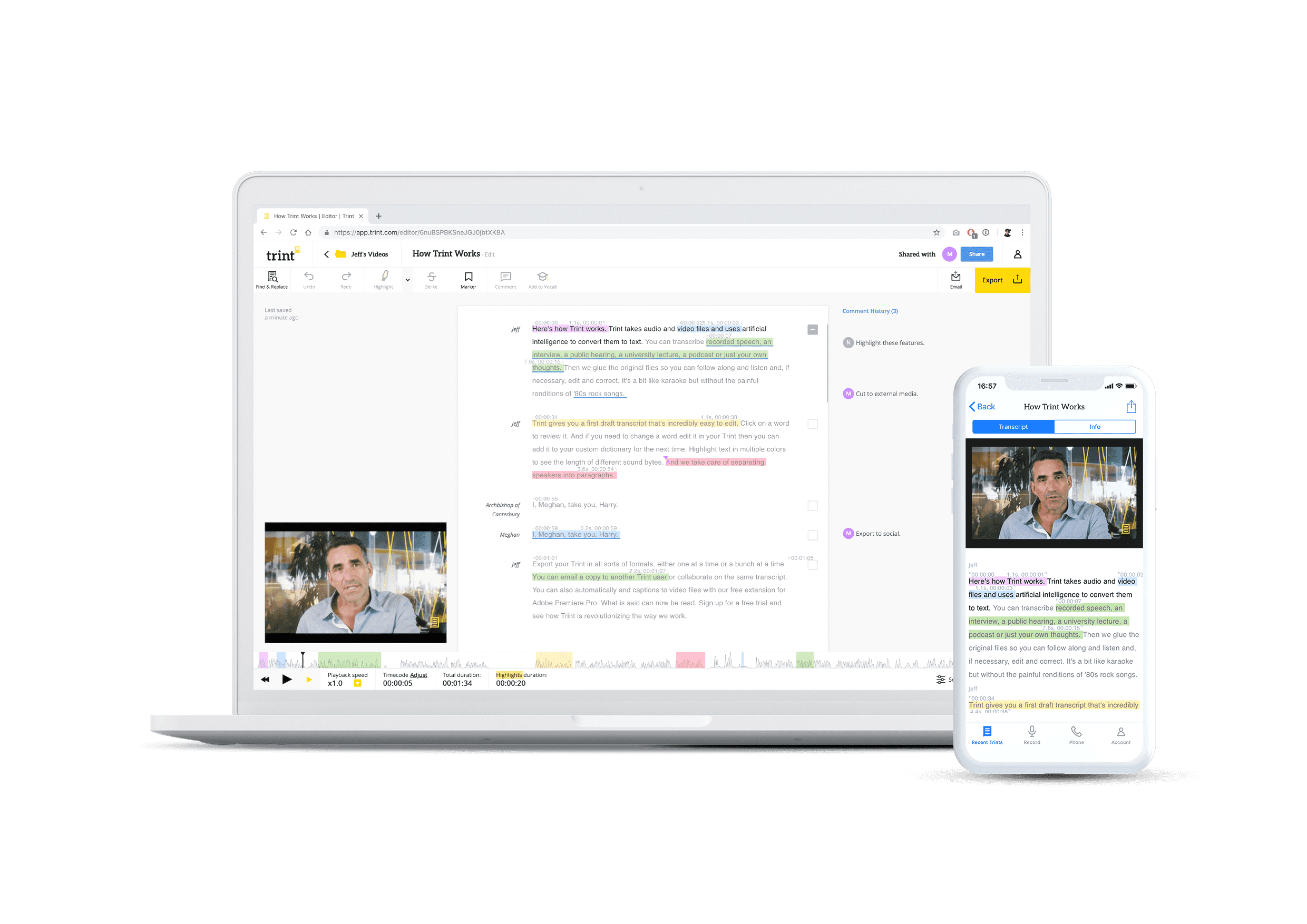Big data is here and it's here to stay. But a lot of this data is an untapped resource for businesses: an estimated 90% of the world's data is unused, and some of it could hold big benefits for small, medium or large enterprise.
Online video is one kind of dark data that holds huge potential. The number of videos posted online is at an all-time high and shows no signs of stopping: according to Cisco, by 2021 a million minutes (17,000 hours) of video content will cross global IP networks every second.

Video is incredibly rich content, but when it's posted online the majority of it stays in the dark. Video SEO is almost nonexistent, so there's currently no way for search engines to 'see' the words spoken in video files posted online. Most online video is underused and largely undiscovered.
For businesses who use video as part of their marketing or as an income stream, this presents a big problem. Video is expensive to create, so businesses of any size need to make sure the video they post online gets seen by as many consumers as possible. The trick to making online video data work hard for businesses is being able to unlock its value. And with a little help from modern technology, namely artificial intelligence and automated transcription, unlocking the value of online video is now possible.
It's time to shine light on dark data in video.
Dark data is data that you have, but don't use.
It's a little bit like those old, dusty receipts from business lunches you have in the bottom drawer of your filing cabinet, shoved all the way in the back. Sure, one day you might take them out, itemize them, put them into a spreadsheet and to send to your accountant to get a slightly deduction on this year's tax return. But that's probably not going to happen.

Dark data usually applies to businesses: we're living in the days of data-driven business, and companies are gathering as much information as possible, even if they don't have time to analyze all of it.
It could be valuable. They might get to it someday. It might show insights that help the company in small ways. So businesses continue to gather and store data - but they don't have a way to use it.
The reason businesses (and individuals with reams of receipts) don't do anything with dark data is because there's no guarantee it will show enough benefits to be worth the time - so dark data stays in the dark.
A lot of dark data is unstructured, so analysis isn't straightforward and it can take a long time to process. Most unstructured data is stored as text, but the lack of structure makes it hard to analyze.
Let's go back to the example of receipts from business lunches. Picture this: every time you spend money on a business lunch, you send yourself an email with the name of the restaurant, the name of the business contact and the amount you spend so that you don't go over your monthly and yearly expense budgets. Toward the end of the month when it's time to total these costs, you search for each of these expense emails in your inbox, then add the amounts of the lunches together to get the total. On the other hand, if instead of emailing you entered all of your business lunch information straight into a spreadsheet, you could keep track of your monthly and yearly expenses automatically, and be able to keep an eye on how you progress each week, month and year.

'Increased data growth over the past decade has created an unstructured data nightmare,' says Gartner research director Alan Dayley. 'It's not just the cost to store it. Huge volumes of dark data make it harder to find what is useful and may mean we miss business opportunities. No matter which types of dark data your organization collects, or how it is stored, the key to keeping data out of the dark is to ensure that you have a means of translating it from one form to another and ingesting it easily into whichever analytics platform you use.'
Dark data doesn't give quick insight. You can't upload it to analysis software and immediately get back ways to save money or make processes more efficient. So it stays stored in logs in a data center somewhere, never to be used.
The trick to making dark data work for your business is knowing what data to use; the type of data that will provide the most value depends on the type of business.
For example, companies that use a lot of photographs and images will find image recognition software an invaluable way to categorize and organize their image libraries, making it easy to search for specific subjects in images, show gaps in their content and give customers easy access to all their images. The dark data - in this case, metadata and tags that are added to photographs - would completely change the way they operate.

For businesses that publish video online, the key to unlocking value is 'speaking Google.' This doesn't mean taking a foreign language course or learning how to code - the answer is a lot simpler. Google speaks text: when you look something up online, the search results you see are the product of Google analyzing billions of websites using a wide range of factors, all of which depend on data being in text format.
Right now, Google is limited on the amount of text attached to an online video. This usually consists of a title and a handful of keywords in video metadata, and unfortunately this is the entire scope of most video SEO right now. But this amount of text only scrapes the surface of what's actually stored within a video, so Google is less likely to show your video in search results because it doesn't know the details of what the video contains.
Online video has to play by the rules of online search and 'speak Google' - aka text. To do that, and to have the best chance of being discovered online, the speech in video has to be converted to text, a process called transcription. And by using artificial intelligence, which is not only accessible but affordable with online transcription services for enterprise, businesses can unlock the value of their video files and see immediate results.
The first step in optimizing online video for search is to capture the content. To do this, you need to convert video to text - that's how we translate video data into Google's preferred language of text.
Previously, transcription was done by a human; but this was a slow, very expensive process, and any audio or video files that were passed to a third party posed a security risk to businesses.
The easiest, fastest and least expensive way to transcribe video today is with automated transcription service Trint. Using artificial intelligence, Trint's automated speech recognition extracts the spoken word in video and turns it into an interactive transcript. This process happens in minutes, can transcribe multiple video file types and leaves your online video ready for step 2.
There's an added bonus: text video transcripts can also be used to add subtitles and captions to video.

Once the speech in the video has been converted to text, the next step is to find the valuable parts of your video. If you're going to produce a short cut to publish online, you can use Trint's highlights and export to EDL to save cutting time in your video editing software. If your final cut is ready to go, you just need to double check the video transcript for accuracy (AI isn't perfect - although it's pretty close at 95% accuracy with good-quality audio).
For the most efficient process, you can edit video transcripts collaboratively. When you work together with colleagues, work gets done faster and content gets published - and indexed by Google and other search engines - sooner. Invite colleagues to work with you, then make use of collaborative editing tools: use Multicolored Highlights to point out important sections, add Comments to start a conversation with a colleague and Verify to signal when each paragraph has been checked and is ready to publish.
The last step in unlocking online video is the exciting part: it's time to share your content with the world. To do this, you'll need to combine your video with a transcript to make your video discoverable online. The most basic, although clunky, way to do this is to publish your video and transcript on the same page of your website; but transcripts take up a lot of space and may not look right with the website's design, so it's best to keep the transcript as small as possible.
The Trint Player transforms online video into a discoverable, interactive experience. It's an elegant hybrid video and transcript player that you can publish directly to your website with a simple embed code.
Creating a Trint Player takes less than a minute - no coding necessary:
1. Open the transcribed and edited video on Trint
2. Select 'Share' and paste the YouTube link to the video (video must be published on YouTube first - see here for instructions on uploading videos to YouTube)
3. Click 'Create your Player' to get your unique embed code, ready to be added to your website
Watch to see how easy it is to create a Trint Player:
There are lots of benefits to using the Trint Player:
1. Expand your reach Previously, your online video was only searchable by a few words in the title and metadata. Now, search engines will index the page using every single word in the transcript - tens, hundreds or thousands of words, all of which are visible to search engines.
2. Attract the right viewers Search engines like Google will also have a better idea of how to categorize the video with the most accuracy, using context from the additional keywords in the transcript, and present your video in related search results. Unmatched video discoverability and enhanced SEO make it easy for the right customers to find your content.
3. Video becomes interactive and accessible Viewers can follow, find and engage with moments that matter: give your viewers the tools to find and focus on key moments.
Google is built to show the most relevant search results for each search that someone performs. When the spoken word in your video is in a searchable text format, it 'speaks Google' and has a much better chance of appearing in search results. By embedding your video with a transcript, you've created the most relevant version of your video content: every single word that's spoken is searchable online.
To see how the Trint Player can be part of your company's enterprise strategy for the spoken word, see our Enterprise page or fill out this form:
Fill out this form to request a virtual demo:

Michael worked for 8+ years as a manual transcriber in the US and UK before building an in-house transcription department for a mobile-to-web software company. He then moved to content marketing and now works in digital marketing. Michael loves to write about emerging technology, digital trends and the ways technology makes our lives easier.